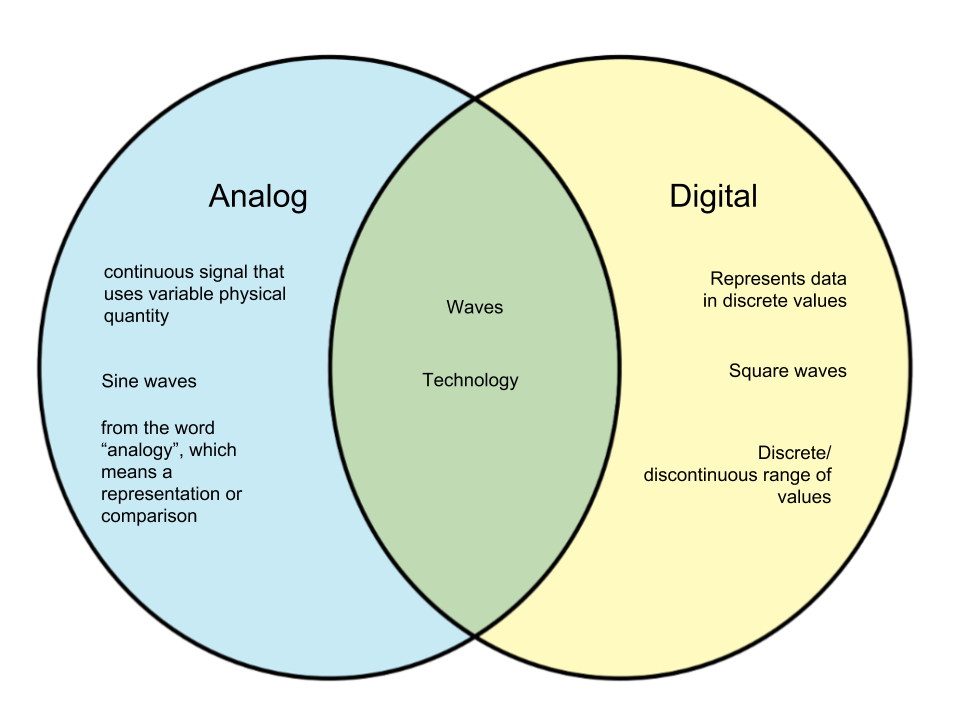Difference Between Analog and Digital Communication
The significant contrast among Analog and Digital Communication is that Analog correspondence utilizes simple sign for transmission and gathering of information while computerized correspondence utilizes advanced sign for transmitting and accepting information. Simple sign are the persistent time-fluctuating sign while advanced sign are those which comprise of discrete qualities.Computerized correspondence gives different points of interest all things being equal resistant to clamor and mutilation as it has more noteworthy sign to commotion proportion. The employments of repeaters in the event of computerized correspondence improve the SNR (Signal to Noise Ratio) further. Additionally, advanced correspondence requires less power than simple correspondence.
Different contrasts among Analog and Digital Communication can be comprehended with the assistance of examination graph and key contrasts.
What is Analog Signal?
At its base, an analog signal is a persistent signal where one time-changing amount, (for example, voltage, pressure, and so forth.) speaks to some other time sensitive variable. As such, one variable is an analog of the other. The outcome is that analog frameworks take into account a hypothetically interminable number of qualities to be spoken to: it can accomplish any an incentive inside the parameters overseeing the framework.For instance, envision a dimmer change attached to a light. In an ideal analog framework, the dimmer will have an unbounded number of positions among "off" and "full" – and a correspondingly vast number of levels of yield by the light. The yield by the bulb is analogous to the time-subordinate variable "position of the dimmer switch."
Contrast Among Analog and Digital Signal
Digital signals, on the other hand, express variety in the framework's variable in light of a lot of discrete qualities (progressively like a light with an "on/off" switch or a three-path bulb with various, discrete degrees of yield).Instances of Analog Signals
In principle, we can utilize the expression "analog signal" to portray any persistent signal that utilizations one time-factor amount to speak to another, (for example, mechanical frameworks like a dial thermometer). Be that as it may, for our motivations, we use it most usually to depict electrical signals.We utilize analog signals in a wide assortment of utilizations, for example,
- Sound chronicle and proliferation
- Live stable/enhancement gadgets
- More established video signal transmission innovations (VGA, S-Video, and so on.)
- Radio signals
- Transmission signals (as of not long ago)
At a certain point in time, analog PCs were even accessible. These early registering gadgets were utilized to figure complex logical and mechanical issues before the advancement of adequately incredible digital PCs. They utilized different physical marvels, (for example, electrical or mechanical amounts) to display the issues to be settled.
In about all cases, digital variants have displaced their analog partners. One ongoing model is the omnipresence of digital Transmission or HDMI video guidelines. In 2019, all new purchaser televisions are digital, similarly as all customer PCs have been for a long time. It is significant, in any case, that in sound chronicle, both analog and digital are at present in ordinary use, each with its own supporters.
Main concern: Analog versus Digital Signals
Analog signals speak to one persistent variable as the aftereffect of another consistent time sensitive variable. They are equipped for yielding consistent data with a hypothetically unending number of potential qualities.We have seen analog signals being used in almost every sort of signal preparing and buyer gadgets application possible. By and large, they have been supplanted by digital adaptations, however analog procedures are as yet basic in the sound chronicle space nearby digital account hardware.
[Electrical And Electronics Engineering]





0 Comments